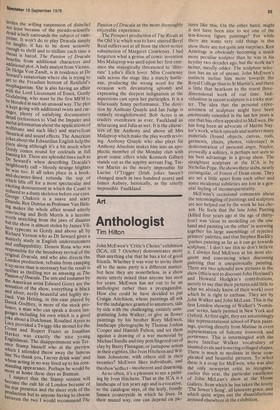Art
Anthologist
Tim Hilton
John McEwen's 'Critic's Choice' exhibition (ICA, till 7 October) demonstrates more than anything else that he has a lot of good friends. Whether it was wise to invite them all to the same party is a different matter: but here they are nonetheless, in a show more utterly mixed than anyone has seen for years. McEwen has set out to be an anthologist rather than a propagandist. How else could he have decided to put Craigie Aitchison, whose paintings all ask for the indulgence granted to amateurs, side by side with the challenging, entirely uningratiating John Walker; or give us flower paintings by his brother Rory McEwen, landscape photographs by Thomas Joshua Cooper and Hamish Fulton, and set them against a drawing of a war memorial by Michael Sandie and tiny pots fingered out of clay by Barry Flanagan; or juxtapose artists in their eighties, like Ivon Hitchens and William Johnstone, with others still in their twenties? McEwen likes individuals, and the,show'seffect— incoherent and disarming. As so often, it's a pleasure to see a painting by Ivon Hitchens. That at the ICA is a landscape of ten years ago and is evocative, so the catalogue says, of the leafy, frondy Sussex countryside in which he lives. In their muted way, one can depend on plc tures like this. On the other hand, might it not have been nice to see one of the less-known figure paintings? For while there are some very odd things in this show there are not quite any surprises. Ken Armitage is obviously becoming a much more peculiar sculptor than he was in his heyday two decades ago, but the work isn't better, merely odder. The sculpture selection has an air of unease. John McEwen's instincts incline him more towards the Royal College than to St Martin's, and there is little that hearkens to the truest threedimensional work of our time. Individualism in recent sculpture is a tricky matter. The idea that the personal expressiveness of sculpture might have been enormously extended in the last few years is one that has often appealed to McEwen. He has long been an advocate of Martin Naylor's work, which spreads and scatters many materials (found objects, canvas, rods, garments, chairs, photos, videotape) in demonstration of personal angst. Naylor, avowedly a solitary, is perhaps not seen to his best advantage in a group show. The straightest sculpture at the ICA is by Nicholas Pope. He shows three slabs, nearly rectangular, of Forest of Dean stone. They are set a little apart from each other and some incidental subtleties are lost in a general feeling of inconsequentiality.
McEwen's occasional comments about the intermingling of paintings and sculpture are not helped out by the work he has chosen. He feels that the late John Panting (killed four years ago at the age of thirtyfour) was 'close to modelling on the one hand and painting on the other' in screwing together his large assemblage of rejected printers' palettes, and that Stephen Buckley 'pushes painting as far as it can go towards sculpture.' I don't see this so don't believe it. I always find McEwen at his most eloquent and convincing when discussing painting that is unequivocally painting. There are two splendid new pictures in the show (this is not to discount John Hoyland's and Howard Hodgkin's contributions, merely to say that their pictures add little to what we already know of their work) over which he is right to enthuse. They are by John Walker and John McLean. This is the first London showing of Walker's 'Numinous' series, lately painted in New York and Oxford. At first sight, they are astonishingly like representational school-of-Paris paint ings, quoting directly from Matisse in overt representation of balcony ironwork and persiennes. This is intermingled with the more familiar Walker vocabulary of blunted ovals and towering collaged shapes.
There is much to meditate in these complicated and bedutiful pictures. To select these is a coup for McEwen, who was also the only newsprint critic to recognise, earlier this year, the particular excellence of John McLean's show at the House Gallery, from which he has taken the lovely 'The Sower's Song', all latescent grace, and which quite wipes out the dissatisfactions aroused elsewhere in the exhibition.


































 Previous page
Previous page